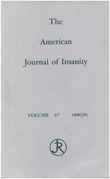T2 hyperintensities in bipolar disorder: magnetic resonance imaging comparison and literature meta-analysis
Abstract
OBJECTIVE: Accumulating evidence suggests a greater number of T2 abnormalities in the brains of patients with bipolar I disorder. The authors sought to evaluate the presence of signal "hyperintensities" in both bipolar I and II subjects and systematically review the existing literature. METHOD: Magnetic resonance images of the brain were obtained prospectively for 29 patients with bipolar I disorder, 26 patients with bipolar II disorder, and 20 normal comparison subjects. The presence and location of signal hyperintensities in three brain regions (periventricular white matter, subcortical gray matter, and deep white matter) were evaluated. RESULTS: No significant differences were found between groups for the presence of subcortical gray or deep white matter hyperintensities. Periventricular hyperintensities were more common in bipolar I patients (62%) than in bipolar II patients (38%) and normal comparison subjects (30%). Within patient groups, medication use was not significantly different for those with or without the presence of white matter hyperintensities. The literature on bipolar disorder and signal hyperintensities is reviewed. A meta- analysis of the pooled data in the literature on bipolar illness and signal hyperintensities revealed that the odds of having a T2 hyperintensity are significantly greater for bipolar I than for normal comparison subjects. CONCLUSIONS: Having bipolar I disorder significantly increases the chance of having white matter changes in the brain. This study suggests that bipolar II patients may be more similar than bipolar I patients to comparison subjects on T2 measures. The possible pathophysiological significance of hyperintensities is discussed.
Access content
To read the fulltext, please use one of the options below to sign in or purchase access.- Personal login
- Institutional Login
- Sign in via OpenAthens
- Register for access
-
Please login/register if you wish to pair your device and check access availability.
Not a subscriber?
PsychiatryOnline subscription options offer access to the DSM-5 library, books, journals, CME, and patient resources. This all-in-one virtual library provides psychiatrists and mental health professionals with key resources for diagnosis, treatment, research, and professional development.
Need more help? PsychiatryOnline Customer Service may be reached by emailing [email protected] or by calling 800-368-5777 (in the U.S.) or 703-907-7322 (outside the U.S.).



